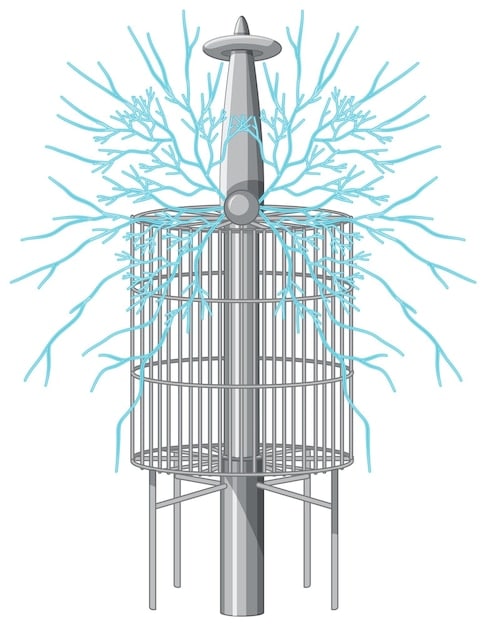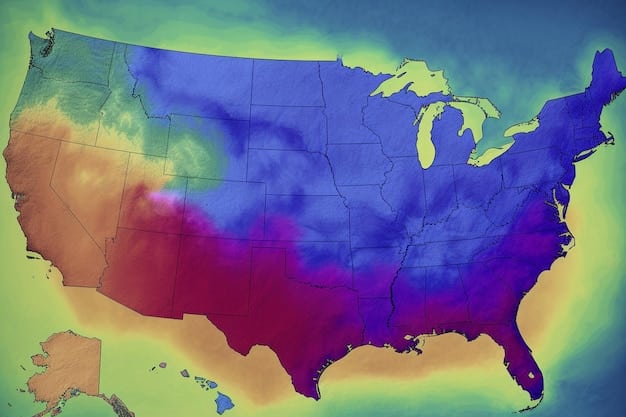Wave Energy: Powering the US Coastline Beyond Solar by 2030

Wave energy technologies offer a promising alternative to solar panels for powering the US coastline, harnessing the ocean’s kinetic energy to generate electricity and contribute to a sustainable energy future by 2030.
As the quest for renewable energy intensifies, the focus is increasingly shifting Beyond Solar Panels: Exploring the Emerging Wave Energy Technologies Poised to Power the US Coastline by 2030. This exploration delves into the potential of wave energy to transform coastal power generation.
Understanding Wave Energy: A Primer
Wave energy, a form of hydropower, taps into the kinetic energy of ocean waves to generate electricity. Unlike solar or wind power, wave energy is more consistent and predictable, offering a reliable source of renewable energy.
How Wave Energy Works
Wave energy converters (WECs) are devices designed to capture the power of ocean waves. These converters can take various forms, each utilizing different mechanisms to transform wave motion into electricity.
There are several types of wave energy technologies:
- Oscillating Water Columns (OWC): These devices use the rising and falling motion of waves to compress air, which then drives a turbine.
- Point Absorbers: These floating devices move up and down with the waves, using this motion to drive a generator.
- Overtopping Devices: These devices capture water as waves surge over them, using the stored water to turn turbines.

These technologies are still in development, but they hold immense potential for providing clean energy to coastal communities.
In conclusion, wave energy presents a compelling alternative to traditional energy sources, offering a consistent and predictable renewable energy source. The various WEC technologies each offer unique advantages, paving the way for a diverse and robust wave energy sector.
The Promise of Wave Energy for the US Coastline
The US coastline, with its vast exposure to ocean waves, is ideally suited for wave energy development. Utilizing this resource could significantly reduce the nation’s reliance on fossil fuels and enhance energy security.
Potential Energy Output
Studies suggest that wave energy could potentially generate a significant portion of the electricity needed to power coastal communities. The Electric Power Research Institute (EPRI) estimates that wave energy could supply up to 10% of the US’s electricity needs.
Wave energy projects offer several benefits:
- Reduced Carbon Emissions: By replacing fossil fuels, wave energy can significantly lower carbon emissions.
- Enhanced Energy Security: Wave energy is a domestic resource, reducing reliance on foreign energy sources.
- Economic Development: Wave energy projects can create jobs and stimulate economic growth in coastal regions.

While challenges remain, the potential benefits of wave energy make it a worthwhile investment for the US.
In summary, wave energy presents a significant opportunity for the US to enhance its energy independence, reduce carbon emissions, and foster economic growth. The consistent and predictable nature of wave energy makes it a valuable addition to the nation’s renewable energy portfolio.
Key Wave Energy Technologies Being Developed
Several innovative wave energy technologies are currently under development, each with unique design and operational characteristics.
Leading Wave Energy Converters
Among the most promising WECs are:
- Ocean Power Technologies (OPT) PowerBuoy: This point absorber technology is designed to generate electricity from the motion of waves.
- CalWave xWave: This submerged pressure differential technology captures energy from pressure fluctuations caused by waves.
- Columbia Power Technologies’ StingRAY: This oscillating wave surge converter harnesses the horizontal motion of waves.
These technologies are being tested in various locations around the world, including the US, Europe, and Australia. Continuous improvements are being made to enhance efficiency and reduce costs.
In short, the development of wave energy technologies is progressing rapidly, with several innovative designs showing promising results. With continued research and development, these technologies have the potential to become competitive with other renewable energy sources.
Challenges and Obstacles Facing Wave Energy
Despite its potential, wave energy faces several challenges that must be addressed to ensure its widespread adoption.
Environmental Concerns
One of the primary challenges is minimizing the environmental impact of wave energy devices. Potential impacts include:
- Effects on Marine Life: WECs could potentially harm marine life through collision or habitat disruption.
- Coastal Erosion: WECs could alter wave patterns and contribute to coastal erosion.
Careful planning and environmental impact assessments are essential to mitigate these risks.
In addition to environmental concerns, there are also technical and economic challenges to overcome. The harsh ocean environment can be demanding on WECs, requiring robust designs and regular maintenance.
In essence, despite its promise, wave energy faces significant hurdles related to environmental impact, technical reliability, and economic feasibility. Addressing these challenges through research, innovation, and careful planning is crucial for realizing the full potential of wave energy.
Policy and Investment: Driving Wave Energy Forward
Supportive policies and strategic investments are crucial for advancing wave energy development in the US. Government incentives, research funding, and regulatory frameworks can help accelerate the deployment of wave energy technologies.
Government Initiatives
The US Department of Energy (DOE) has invested in wave energy research and development through various programs. This includes funding for WEC testing facilities and research grants. Policies that promote renewable energy, such as tax credits and feed-in tariffs, can also encourage wave energy development.
Investing in infrastructure is also crucial for integrating wave energy into the grid. This includes upgrading transmission lines and developing energy storage solutions. Collaboration between government, industry, and research institutions is essential for advancing wave energy.
In conclusion, supportive policies and strategic investments are indispensable for fostering the growth of the wave energy sector in the US. Government initiatives, private sector investment, and collaborative partnerships are essential for overcoming barriers and realizing the full potential of wave energy.
The Future of Wave Energy: Predictions for 2030
Looking ahead to 2030, wave energy is poised for significant growth and technological advancements. Predictions suggest that wave energy could play a more prominent role in the US energy mix, contributing to a more sustainable and resilient energy system.
By 2030, we can expect to see:
- Increased WEC Efficiency: Technological advancements will lead to more efficient and cost-effective WECs.
- Larger-Scale Projects: Wave energy projects will become larger and more integrated into coastal communities.
- Grid Integration: Improved grid infrastructure and energy storage solutions will facilitate the integration of wave energy into the power grid.
These developments will drive down the cost of wave energy and make it more competitive with fossil fuels.
In summary, the future of wave energy looks promising, with technological advancements, economies of scale, and supportive policies paving the way for significant growth by 2030. As wave energy becomes more cost-competitive and reliable, it is poised to play an increasingly important role in the US energy landscape.
| Key Point | Brief Description |
|---|---|
| 🌊 Wave Energy Potential | Vast, untapped resource; potential to power US coastlines. |
| ⚡ Key Technologies | Oscillating Water Columns, Point Absorbers, Overtopping Devices. |
| 🌱 Environmental Impact | Careful planning needed to minimize effects on marine life. |
| 💰 Policy & Investment | Government support crucial for advancing wave energy projects. |
Frequently Asked Questions
▼
Wave energy is a form of renewable energy that harnesses the kinetic energy of ocean waves to generate electricity. Wave energy converters (WECs) capture the motion of the waves and convert it into usable power, often through turbines or hydraulic systems.
▼
Wave energy is more consistent than solar and wind power. It reduces the carbon footprint, enhance energy security by tapping a domestic resource, and create economic opportunities in coastal communities.
▼
Challenges include minimizing environmental impacts on marine life, ensuring the durability of wave energy converters in harsh ocean conditions, and reducing the overall cost of wave energy to make it competitive with other energy sources.
▼
The US Department of Energy (DOE) supports wave energy through research grants, funding for testing facilities, and policies that promote renewable energy adoption, such as tax credits and incentives for renewable energy projects.
▼
By 2030, wave energy is expected to become more efficient and cost-effective due to technological advancements. The integration of larger wave energy projects into coastal communities and enhanced grid infrastructure will also support its growth.
Conclusion
In conclusion, wave energy stands as a promising, viable alternative to traditional energy solutions, offering a more reliable and consistent source of renewable power compared to solar and wind. By addressing current challenges and fostering innovation, wave energy can play a crucial role in powering the US coastline by 2030 and beyond.





